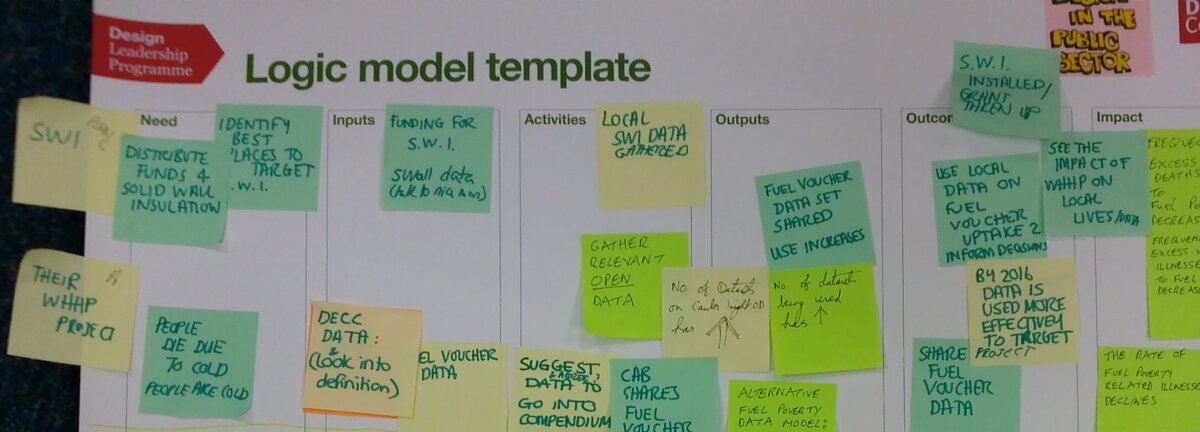Design in the Public Sector: Cambridgeshire Council’s insights – Part II

Design Council’s Design in the Public Sector programme increases the knowledge and use of strategic design skills across local authority public services, exposing teams to new ways of working and enabling them to do something practical to meet their challenges in a relatively short period of time.
Here Sue Beecroft, Housing Co-ordinator at Cambridgeshire County Council, talks about the second workshop.
The second session of Design Council’s Design in the Public Sector course was a real eye-opener for the Cambridge team.
We’d worked hard to test out some ideas and a pilot product on a group of professionals who are working to reduce fuel poverty across Cambridgeshire, with the idea we could learn about how to make data more useful and practical, for a thorny issue like this, in future.
That’s a big task, and our work on the first two-day session had helped us work out that, although helping make data the foundation of policy was pretty ambitious, it was still possible with a targeted approach. So we homed in on the fuel poverty task as an example of great partnership working where we might be able to add value, and to seek people’s feedback on what works and what doesn’t.
So, focus in design is a big lesson that we have developed and refined.
This is how our journey leading to the second session can be summarised, very briefly…
Logic Models
We created a ‘logic model’ for each of the targeted levels of our project, with each level more finely focused on a specific need than the level before (which you can see in the image below):
These three levels are all achievable in time, but we are really enthusiastic about hitting the third, most pressing, practical and detailed area, as hard and fast as we can. Here’s a summary of our logic model for the third, most immediate project:
Logic model: solid wall insulation
Need
- To distribute funds for Solid Wall Insulation - targeted at the best places to reduce fuel poverty.
- So our data needs to focus on where there are the most solid walls, and where there are the most people on low incomes or who are most vulnerable.
Inputs
- Government funding to be spent by March 2016.
- Data which highlights where solid walls are found (mainly, homes built before 1930).
- Data about income, deprivation and vulnerability.
- Data about access to mains gas (or not).
- Data indicating rurality.
- Data about housing tenure (this is the part of work needed to achieve the decent homes standard), as social housing tends to be better insulated than privately owned and rented housing, which may not have been invested in.
Activities
- Find and gather local, open, small area data where available.
- Develop ways to help users compare different issues / factors to identify hotspots to target.
- Ensure the data is usable, accessible and discoverable.
Outputs
- A better, easier focus on areas most likely to have people who need the grant.
Outcomes
- Solid Wall homes have insulation installed.
- The grant is spent where it is most needed.
- Fuel poverty is reduced in homes with solid walls.
- Future iterations of similar projects will have a data baseline to start with.
Impact
- People living in homes which are the most difficult to heat can keep warm more affordably.
- Fuel poverty reduced.
- Discomfort, illness and even deaths due to cold are reduced.
- More homes in Cambridgeshire are brought up to modern insulation standards.
By helping create the data in such a way that specific small areas are identified where the grant might most usefully be used, we can help:
- Publicise and promote the grants towards the ‘best’ areas.
- Monitor take-up in these areas.
- Officers refine the factors used and identify second and third priority areas.
- Implement a monitoring system to show how effective this targeting has been.
In this way, we can focus in on a very practical task, using real information.
Benefits of an open data approach
The benefit of the approach we are taking is that we can scale the work to be realistic with our available resources. As we are taking an open approach, it also allows us to gather evidence and promote collaboration.
As an example, we can share and use this pilot to plan, refine and develop our approach and eventually work our way ‘back up’ to our loftier aims, once people see the cost-effectiveness and other benefits of a data-driven approach to local insights.
Sue will continue to blog about Cambridgeshire County Council’s experience and you can keep up to date here.
Subscribe to our newsletter
Want to keep up with the latest from the Design Council?
